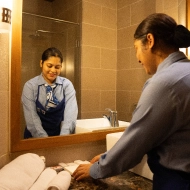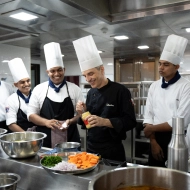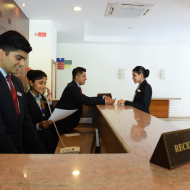
If one has to experience the true essence of Goa, then it is mandatory to visit a Goan village. These villages are an epitome of a quaint life where you will come across hard-working farmers, curious grocery store owners, and ever-helpful villagers. However, the one thing that will immediately grab your attention is the natural beauty of hillocks overlooking rivers, ponds, and backwaters. The village of Raia in South Goa where the V. M. Salgaocar Institute of International Hospitality Education (VMSIIHE), is situated is one such village. Like many other places, it has its own charm and history.
Raia is located 7 kilometers from Margao, 35 kilometers from the capital city of Panaji, and around 27 kilometers from the Dabolim airport. The village shares border with other South Goa villages – Loutolim, Ambora, Rachol, and Maina Curtorim on three sides and the river Zuari on the other. This village is blessed with the beauty of green paddy fields dotted with coconut trees, colorful traditional Goan houses, and whitewashed churches.
The History
This quaint village of Raia has an interesting piece of history that involves a tragic past that is now connected to our present situation. Anyways, let’s first know about its name. Former Union Minister, Eduardo Faleiro, who hails from this village says that the name Raia is derived from a Kadamba king (the Kadamba dynasty ruled Goa from 11th to 14th Century). In an article to a local daily he mentions, “Raia derives its name from Agni Mukha Roy, one of the earlier Kadamba Kings who established his headquarters in this village.” He further mentions Fr. Jorge Sequeira; according to him, the village was named at different times as Rayanagara, Rajapur, and Rayapur. With the decline of the Kadamba dynasty, it became known simply as Raya and then Raia. It is also believed that Raia was one of the first villages to be Christianised in South Goa.
The prominent building of this village is the Our Lady of Snows Church which was built in the year 1699. The main festival associated with this Church is the ‘Konsache Fest’ or the Feast that celebrates the first harvest. It is celebrated on August 5, every year. Such festivals indicate the agrarian lifestyle and the importance of farming in the village. Raia also has the oldest sporting club in Goa and the oldest inter-village football tournament in the state – the ‘Custodio Memorial Trophy’. It which started by Peter D’Souza in memory of his brother Custodio D’Souza in 1971 to commemorate his memory.
Tragic past that’s connected to our present
In the month of July-August 2020, the village of Raia caught the attention of many due to a structure that is placed outside the main cemetery of the village. It is a structure with a cross on it with an inscription, “E M (Em Memória) das vítimasde gripe de 1918.” It means, ‘In Memory of the Victims of the Flu of 1918. It is believed that this is a memorial built-in memory of those who died of the Spanish Flu (An influenza pandemic that lasted from 1918 to 1920 and it affected 500 million people). It even affected Goa and the village of Raia and it is assumed that hundreds of villagers died due to this flu. In the last few months, the villagers managed to repair this memorial as the cases of COVID-19 (that caused pandemic and lockdown in the world) started rising in Goa. Villagers have now started praying here hoping that we get out of this situation soon and for the betterment of the people. It is quite strange how our past can relate to our present.
The Cuisine
This historical place is also known for its cuisine. There are many eateries and restaurants where you can get typical Goan food. But, to understand the finer nuances of Goan cuisine that has an influence on various cultures—try out Fernando’s Nostalgia. It is a family-run Goan restaurant in Raia, managed by Margarida, whose husband chef Fernando started this restaurant. Its interiors are brimming with artifacts that speak about Indo-Portuguese culture. The restaurant serves Goan culinary delicacies such as Caldeirada, Caldinho, Panados, Rolados, Xacutis, Vindalhos, Cafreal, Recheiados, Feijoada, Balchao, Ambot-tik, Rosachi Codi,
Moongancheo Ganteo, Hotcottem, Sukem, Chouli Ros, to name a few. The restaurant blog mentions, “This restaurant is probably among the very few eating houses, that serves freshly made sannas with sorpotel and bakes the great dessert “Bolo Sansrival” which is practically non-existent in Goa anymore.”It would not be incorrect to say that this restaurant has placed Raia on the global culinary map. Raia lads Lerrick and Lineker Coelho were in the limelight recently when they were selected to
participate in the ‘Great British Bake Off: The Professionals’, one of the biggest televised pastry competitions in the United Kingdom. The duo has a progressive approach to patisserie, drawing on flavors and techniques from the rich culture and heritage of Goa. Raia is indeed a historic place that’s filled with Goa’s history, culture, cuisine, and essence that makes Goa in many ways.
Hoping that Raia and Goa keep on inspiring you all.
Links of the websites referred:
https://www.heraldgoa.in/Opinions/Raia-my-village/155736
https://www.hindustantimes.com/cities/once-forgotten-1918-spanish-flu-memorial-gains-following-amid-covid-19-scare-in-goa/story-VobuVy0yfCusX9P4OCFROM.html
https://fernandosnostalgia.wordpress.com/restaurant/









